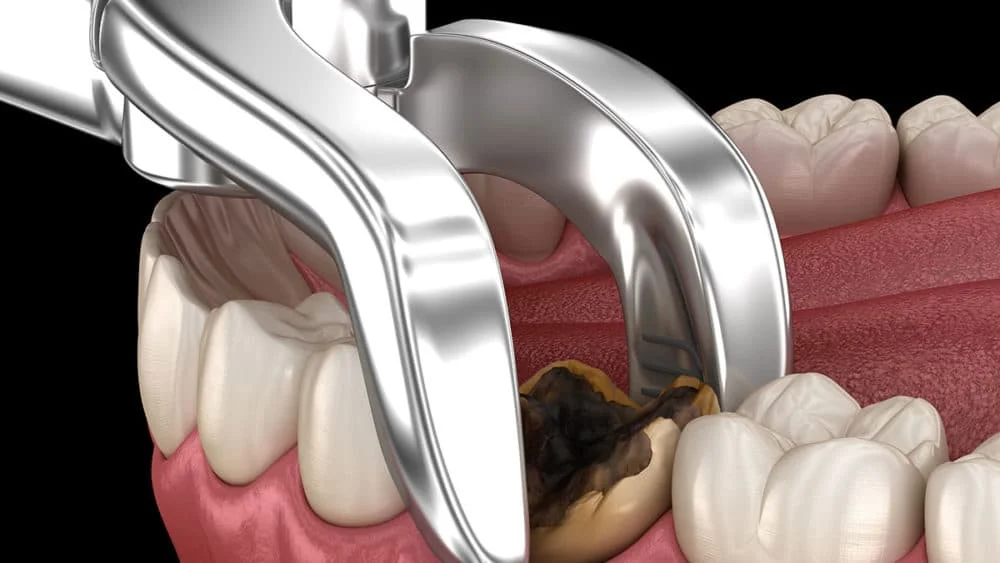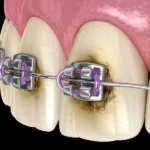Recent Posts
Tooth Extraction Healing Time

A tooth extraction procedure involves the removal of a tooth from its dental alveolus or socket, usually performed by a dental surgeon. There are many reasons to get a tooth extraction, including;
- Severe decay that leads to irreparable damage of teeth
- As a solution to periodontal disease
- To curb teeth overcrowding
- To help with an impacted tooth, especially common with wisdom tooth extraction
- Following severe accidents, like car crashes
A simple tooth extraction will involve teeth that are visible in the mouth and is done under local anesthesia to curb tooth extraction pain.
A surgical extraction is performed when the tooth cannot be accessed easily when a tooth has not fully
erupted or broken under the gum line.
Table of Contents
How Long Does A Tooth Extraction Take To Heal?
Aftercare may be different based on the location of your tooth and the extraction procedure. Generally, in seven to ten days, healing should be underway.
Maintaining the blood clot in place during the healing process is essential, and the dentist’s advice is always good to go with.
Some measures you can take to speed up the tooth extraction healing process are;
- Using the prescribed painkillers to eliminate any tooth extraction pain
- Resting for 24 hours after the operation, and minimizing intake of hard foods that may disturb the gum.
- Not removing the initial gauze until two to three hours post tooth extraction.
- You can apply an ice bag to the affected area after the operation, ensuring to leave it on for not more than ten minutes at a time.
- To avoid dislodging the blood clot, do not rinse your mouth or gargle. Avoid using straws.
- Propping your head with pillows while you sleep as opposed to lying flat can be extremely helpful.
- Use a saline solution to rinse your mouth after 24 hours gently. This helps to prevent any infections on the site.
Try to eat soft foods to minimize chewing and grinding, especially after molar extraction. Some recommended foods include soups, sauces, applesauce, and pudding.
It would be best if you used a spoon to eat these foods for about a week, after which you can now slowly incorporate more solid foods.
The Tooth Extraction Process
- Your orthodontist will begin with a shot of anesthesia for the tooth, bone, and gum tissue surrounding it. You might feel the bite of the needle depending on the surrounding tissue.
- The extraction itself. This is when the dentist enlarges the socket that holds the tooth firmly and separates the tooth from the ligament. The tooth is lifted out of its position by rocking the tooth back and forth against the socket walls.
- The socket is then closed. Removing the tooth leaves the socket literally open, and your dentist will remove any infected or pathologic tissue, then compress the socket using his finger to bring it back to its size.
- The dentist also rounds off any sharp bone edges and looks for any sinus complications in the socket.
- In the case of surgical tooth extraction or the removal of several teeth, the dentist will need to stitch up the area.
- The dentist places a folded gauze over the tooth extraction site. He will request you to bite down on it to create firm pressure and control bleeding.
- Your dentist might offer you an ice pack to place against your face if any post-operative swollen is probable.
- You will be guided on post-operative care in the days following your tooth extraction so as to speed up your recovery.
How Long A Tooth Extraction Takes
How long does it take to get a tooth pulled? You can expect your tooth extraction procedure to take about 20-40 minutes. In the case of multiple teeth extraction, an additional 3-15 minutes per tooth should be allowed.
Wisdom Tooth Extraction
In the case of an impacted wisdom tooth (where a wisdom tooth does not have space to grow), pain, infection, and other dental problems may be experienced.
Your dentist will then recommend the extraction of the wisdom tooth. In other cases, wisdom tooth extraction is recommended even when the tooth isn’t causing problems so as to avert future dental problems.
Usually performed as an outpatient procedure, your wisdom tooth ( or teeth ) may be extracted, and you go home the same day. Signs of normal wisdom tooth healing are then observed.
Depending on the complexity of the wisdom tooth extraction and your comfort level, three types of anesthesia can be used, namely; general, local, or sedation anesthesia.
Your orthodontist will usually;
- Expose the tooth and bone by making an incision in the gum.
- Remove the bone blocking access to the tooth root.
- Your dentist may divide the tooth into sections if it is easier to remove in pieces
- Gently remove the tooth
- Ensure cleaning of any debris from the tooth or bone
- May need to stitch the wound to promote healing. This is usually important following the removal of multiple teeth.
- Place a folded gauze over the extraction site to control bleeding. You will most probably be asked to bite on it for some time to apply pressure.
During your tooth extraction process, you will generally feel no pain because of the numbing. The anesthesia will not relieve the feeling of pressure and any startling noises during the process. These are perfectly normal and should resolve in the day-by-day tooth extraction healing process.
Teeth Removal Healing Timeline
– Day 1
The first day after the extraction, blood clotting begins. It is normal to experience slight bleeding, discomfort, and even some pain. Swelling also reaches its peak in the first 24 hours. Day by day tooth extraction healing commences on this first day.
As long as there is nothing out of the ordinary and you are following your doctor’s advice, recovering from a tooth extraction should take its natural course.
– Day 2
This stage comprises 24-48 hours after the tooth extraction. By now, a clot has formed in the socket, and platelets in the socket have begun to produce chemical factors to speed up the healing process. You will notice that the swelling is starting to subside.
– Day 3
3 days after tooth extraction, the gum tissue surrounding the socket will begin to close up. This marks normal healing after tooth extraction.
– Day 4
This is the final tooth extraction healing process, happening around seven to ten days after the extraction. The hole in the socket has, in most cases, closed up, the swelling has completely gone away, and the patient can now resume eating solid foods 4 days after tooth extraction.
Pain From A Tooth Extraction
It is quite normal to experience mild pain and swelling post-operation. The pain will usually last anywhere between one or two weeks after surgery. What to do after tooth extraction bothers many patients.
Have a friend or relative accompany you for the surgery, so you do not have to drive or operate any machinery when your anesthesia wears off. You might feel drowsy and just want to lie down as the medication leaves your system, so ensure you have someone around you in the 24 hours post-surgery.
Taking pain medication and following your doctor’s advice is very helpful with tooth extraction pain. It is advised that you keep the narcotic painkillers for bedtime.
It is important that while taking your medication, you keep off from operating any machinery and driving. This is because these medications make you drowsy, impairing your performance.
Your doctor may prescribe anti-swelling medication. If your face appears red and feels warm, this is usually a side effect of the medication, and you might need to discontinue it. The swelling usually resolves itself with time, even after molar extraction.
When it comes to prescription mouthwash, you should not rinse or spit in the first 24 hours after surgery. Avoid rigorous and excessive rinsing to ensure you do not tamper with the tooth extraction healing time.
If you experience other side effects such as hiccups, it could be time to discontinue the medication. Always consult your doctor to confirm normal tooth extraction healing.
How Should A Tooth Extraction Site Look Like When Healing?
After extraction, your body starts its natural healing process. Your mouth heals just like any other part of your body, and some studies show that saliva might contain healing properties, so your tooth extraction recovery is faster.
As we have seen, a blood clot will form in the 24 hours following your tooth extraction surgery. Once it has formed, your body starts building granulation tissue to cover the wound.
The tissue looks creamy white and consists of collagen, white blood cells, and blood vessels. It is your way of confirming normal tooth extraction healing stages is on course.
A dry socket could form when the blood clot that forms over your tooth’s socket fails to develop or falls off before your gum fully heals. A dry socket is a relatively common complication, especially with wisdom tooth healing stages.
A dry socket is characterized by:
- Severe pain in days following your tooth removal
- Pain radiating from your socket to your ear, eye, or temple
- Loss of blood clot
- An unpleasant taste in your mouth
Call your doctor right away if you suspect a dry socket. You should be worried if severe pain is not getting better in the days following your tooth extraction recovery.
If you notice white or yellow pus after extraction, it could be a sign of infection. Signs include:
- Swelling that does not subside in 2-3 days
- bad taste in your mouth
- fever and headaches
- prolonged, heavy bleeding after 24 hours
Call your doctor right away if you suspect any infection on the site.
The need to strictly follow all the laid out aftercare measures by your doctor can not be overemphasized. Always ensure you are aiding the tooth extraction healing time in every way you can.
Tooth Extraction Cost Breakdown
We are highly qualified and experienced at Omega Dental Specialists, Houston Texas in all matters of dental and oral health. The cost of getting a tooth extracted in Houston will be dependent on whether you have insurance or not, the number and type of teeth being extracted, among other factors.
Patients without a dental policy will end up paying slightly more for treatment than insured ones.
See also:
- Our comprehensive guide on Wisdom teeth extraction cost.
- Wisdom teeth removal cost with insurance
Takeaway
Always following your doctor’s advice following a tooth extraction is your best course of action. The tooth extraction healing process does not have to be complicated, especially when dealing with a reputable and professional dental clinic like Omega Dentist Specialists.





